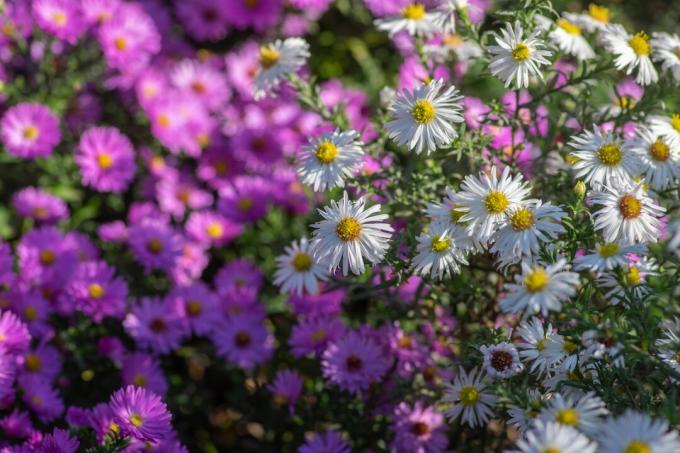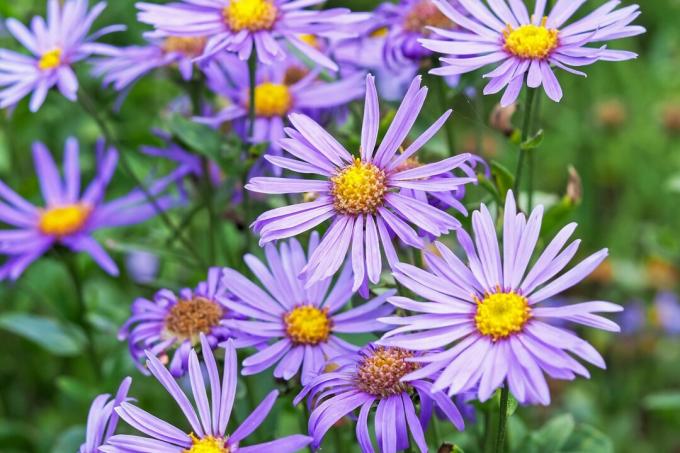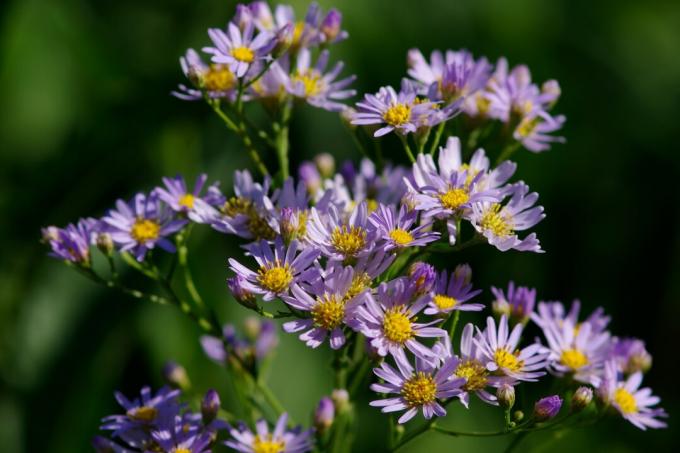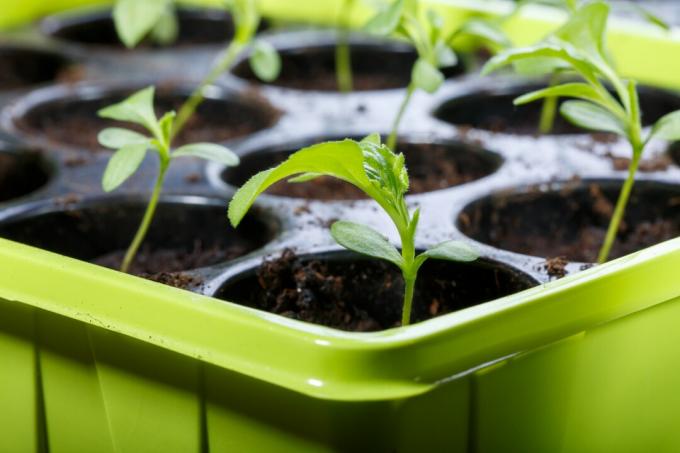Are you still looking for a flowering autumn plant for your garden that is insect-friendly? We introduce you to the Herbstaster. There are numerous colors that show up in the last days of summer at the beginning of their flowering.

Autumn also has a lot to offer when it comes to gardens. autumn asters (symphytricum and aster) are an excellent example of a beautiful floral display - they come in many different colours. In this article we will inform you about what needs to be considered when planting and caring for autumn asters.
Tip: Many asters used to belong to the genus aster, but were in the genus symphytricum transferred. However, some well-known garden asters are still called botanically correct Aster.
contents
- Autumn aster: origin and properties
- The most beautiful autumn aster species
- Planting autumn asters: location, sowing and Co.
-
Caring for autumn asters
- Cut, water and fertilize autumn asters
- Control powdery mildew on autumn asters
- Are autumn asters hardy?
- propagation
- Are autumn asters poisonous?
Autumn aster: origin and properties
Asters from the genus symphytricum originally come from North America and Canada. The genus aster however, is native to Eurasia. Plants of both genera have been found in local gardens for a long time and delight with their late summer flowering.
With a species-dependent growth height of 20 to 140 cm and a width of 30 to 90 cm, the hardy perennials are an eye-catcher in the garden. The herbaceous plants have lanceolate, entire, smooth or rough leaves.
Depending on the species and variety, the radiating flowers can range in color from white to light pink to violet. The yellowish stamens are in the middle. Insects like bees and bumblebees are doing you a favor by planting Japanese asters. They are rich in nectar and are frequently flown over, especially the native mountain aster.
When do autumn asters bloom? The flowering time of the autumn asters extends from the beginning of September to November.

Tip: Occasionally, asters and chrysanthemums (chrysanthemum) confused, because some of them are very similar. Both genera belong to the daisy family (Asteraceae). But there is a big difference between autumn asters and chrysanthemums: the latter are usually not hardy.
The most beautiful autumn aster species
There are different types of autumn asters with very different flower colors. Below we present a few selected ones:
Pillow Aster (Symphyotrichum dumosum)
As the name suggests, the cushion aster grows like a cushion and forms a hemisphere. Due to the squat growth, this variety reaches a maximum height of 20 to 40 cm. The flowers are pink to violet depending on the variety. For a sea of flowers, ten to twelve plants can be planted per square meter, alternatively there should be a distance of 30 cm between them.

Myrtle Aster(Symphyotrichum ericoides)
The myrtle aster has a bushy habit with upright stems and clumps growing to a height of 50 to 100 cm. The flowers are small and white. Due to the small growth width of 45 to 50 cm, four to six plants of the myrtle aster can be planted per square meter or a planting distance of 45 cm is maintained.

Smooth-leaf Aster (Symphyotrichum novi belgii)
The 'Permanent Blue' flowers blue-violet. It reaches a maximum height of 70 to 140 cm. The growth is bushy, the plant forms short runners. In contrast to the other species presented, this one needs moist soil. The growth width is about 70 to 80 cm. For this reason, only one to three plants should be planted per square meter, or a planting distance of 80 cm should be ensured.

Tawny Aster (Symphyotrichum novae angliae)
The varieties of the tawny aster mainly flower in pink to pink tones. The flowers are very large at 10 cm. The growth is clumpy. A growth height of 50 to 100 cm is reached. The leaves are finely hairy and soft. With up to 90 cm, this species grows extremely wide, so plants should be placed at a distance of 90 cm.

mountain aster (Aster amellus)
This very bee-friendly aster grows bushy to a height of between 30 and 60 cm. The flowers are pink to blue-violet and small. Due to their maximum growth width of 40 to 50 cm, plants of this species should grow to around 45 cm Plant spacing can be set or there will be four to six plants per square meter planted.

wild aster (Aster ageratoides)
A very drought-resistant aster species that grows sprawling and tall - the stature height is between 70 and 100 cm. Mostly light violet rather small flowers. The leaves are lanceolate and rough. The planting distance should be about 60 cm, or a maximum of two plants should be planted per square meter.

Planting autumn asters: location, sowing and Co.
Autumn asters like a sunny location. If there is too much shade, the blooming joy of the autumn perennial decreases. The soil must be rich in nutrients, permeable, rather mineral and dry to fresh, since autumn asters do not tolerate soil that is too moist. If your soil is very clayey, you should loosen it up with sand. A very sandy soil, on the other hand, must be touched up with earth. Our peat-free is suitable for this Plantura organic compost. It has a high humus content and thus stimulates soil activity and provides a good supply of nutrients. This in turn ensures lastingly beautiful, lush plants. This soil is also recommended for pot planting.
When do you plant autumn asters? Autumn asters are sold in containers and can be planted on frost-free days between spring and autumn. They are sold in large numbers shortly before they bloom in late summer. Then plant the autumn asters directly.
Tip: Suitable as planting partners for autumn asters in perennial beds ornamental grasses, delphinium (delphinium) and flame flowers (phlox).
Plant autumn asters in pots or window boxes:
Some varieties are not suitable for planting in pots because they grow too tall. But compact varieties like the cushion aster do well on the balcony. Plants should be planted about 10 cm apart from each other. A rain-protected place is also recommended, as this also reduces the risk of infection by powdery mildew. It is also important that there is a drainage layer in the pot so that the soil is not permanently too damp for the autumn aster.

Caring for autumn asters
Autumn asters are easy to care for and frugal. However, there are a few points to keep in mind when it comes to maintenance.
Cut, water and fertilize autumn asters
Immediately after flowering, the autumn aster can be cut back by about a third of its height. Since the stems of the plants serve as winter protection, they should not be cut off close to the ground. In addition, the hollow stems offer insects a place to hibernate. The autumn aster can also be cut back in spring, around March or April. The plant will then sprout again near the ground.
Tip: To get a lush picture throughout the flowering period, cut off wilted flowers directly. This stimulates the autumn asters to form new ones.

The autumn aster should be cast in such a way that the soil is not too wet. The irrigation water should not be poured over the plant, but only the soil should be wetted with water. Asters only need occasional watering when the drought persists or on very sandy soils. Only the smooth-leaf aster should always be kept moist.
Fertilization is recommended annually in spring. This keeps the soil rich in nutrients and allows the plant to grow optimally. For example, our is suitable for this Plantura organic flower fertilizer, whose nutrient ratio is designed for magnificent flowers. The very high proportion of organic components promotes healthy soil life, which sustainably strengthens root growth. In addition, the high potassium content prevents fungal diseases such as mildew and ensures a stable stand.
Control powdery mildew on autumn asters
Powdery mildew on autumn asters is easy to spot. The leaves are covered with a white-grey layer on top. As a result, the plant can no longer carry out sufficient photosynthesis, and the fungus also feeds on assimilates and nutrients. As a result, the autumn aster grows poorly and produces fewer flowers. Various causes can promote an infestation. The fungal infection usually occurs on cool, dewy nights - this can also be the case when the weather is otherwise warm and lacking rain. Asters that are shaded in the morning and plants that are close together are particularly at risk. Poor air circulation and leaves that are damp for a long time in the morning promote the development of the fungal disease. Insufficiently supplied asters with nutrients are also more susceptible than young plants.
When powdery mildew first appears, the affected parts of the plant must be cut off. Do not dispose of them in the compost, but directly in the household waste. The plant can then be gently treated with milk or baking powder.
More to Detection, prevention and control of powdery mildew Find out in our special article.

Are autumn asters hardy?
Autumn asters are basically hardy down to -35 °C or -45 °C - this corresponds to winter hardiness zone 2 - 3. In winter, the stalks of the autumn asters should remain, because they offer the plants sufficient protection.
propagation
Autumn asters can be propagated very easily by dividing the rootstock. Separate it by using a spade in the middle of the aster. The newly won part of the plant can then find a place in another suitable place in the garden. In addition, the mother plant benefits from the division - it is rejuvenated.
Autumn asters can also be propagated by cuttings as well as by division. These are cut in the spring and root very easily in potting soil or cuttings at room temperature.
You can also grow asters from seed: sow the seeds outdoors or in pots placed outside immediately after harvest. At 15 °C they germinate within two weeks.

Are autumn asters poisonous?
Autumn asters are not poisonous, neither for humans nor for pets. On the contrary, the flowers are used as a decoration for dishes and are edible, as are the leaves. However, they should not be eaten immediately after purchasing the asters, as they may be contaminated with fungicides or other pesticides.
In addition to the autumn aster, there are other plants that flower in autumn. In our special article we present you not only the aster but also other of the most beautiful autumn flowers in front.
